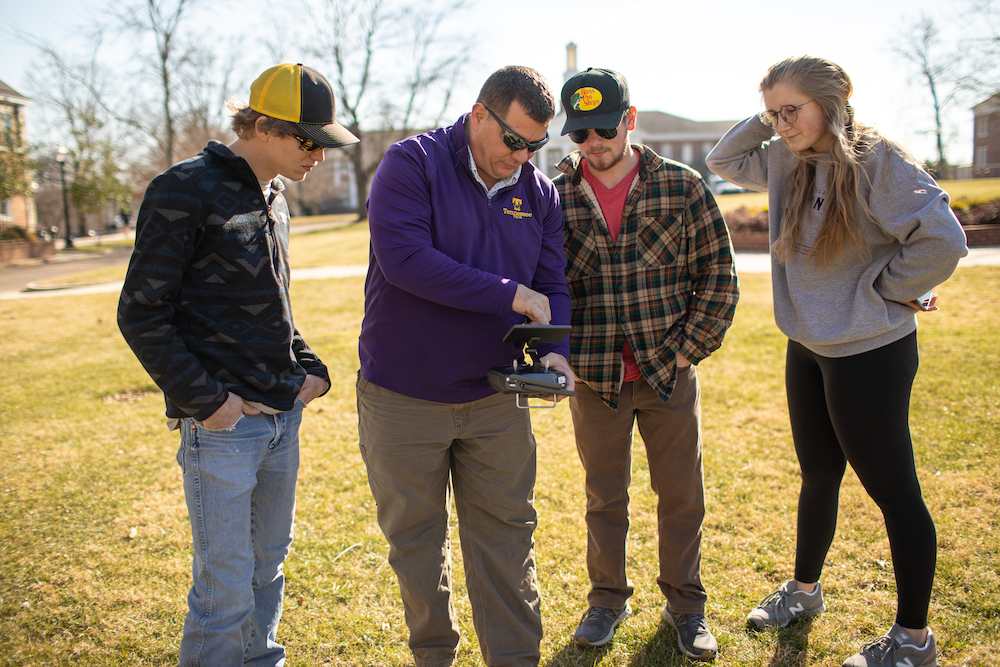
COOKEVILLE, Tenn. — When students start their career in agriculture, they might assume they’ll be caring for the land and the crops by walking the grounds and checking the plants by eye. This future workforce faces the challenge of increasing yields 70 percent above the current production while decreasing fertilizer inputs. Fortunately, Tennessee Tech University provides students with the opportunity to learn and apply innovative technologies to meet the food security demands of growing global population with drone farming.
Michael Nattrass, assistant professor of agronomy and soils in Tech’s School of Agriculture, enjoys showing students – and those with farms all around the Upper Cumberland – that there is a tool that many have not considered using yet: unmanned aerial systems, also known as drones.
“I get so excited talking about drones because I believe they will play an integral role in the future of agriculture, from crops to cattle,” he said. “Often students ask me, ‘Are you teaching that drone class this semester?’ Students are beginning to see the advantages and have a desire to learn more about the technology and applications.”
Drones can be programed for a variety of uses valuable to producers. They can see the crops from the top down and can pass over a field within a matter of minutes instead of the hours it would take to walk the same distance while checking the plants across many acres. Using photogrammetry and GPS, drones can also create a map of the fields that pinpoint exactly where each plant is, and a multispectral camera to measure near-infrared reflectance in order to assess the health of the individual plant.
“Producers can use this data for variable rate fertilizer applications,” Nattrass said. “With this technology, the right amount of fertilizer is applied to plants that need more nitrogen and less to plants that have sufficient nitrogen. Previously, producers applied a broadcast application of fertilizer at a set rate potentially overapplying fertilizer to plants that did not need it. Variable rate fertilizer applications allow producers to maximize the efficiency of their fertilizer application and reduce the amount applied.
“Drones can also be used for pesticides applications,” Nattrass added. “When we detect weed, insect or disease pressure in a particular part of the field, aerial applications of pesticides save time and fuel compared to driving the sprayer to the location to make a broadcast application. These two applications can improve both economic and environmental sustainability in Tennessee.”
Nattrass teaches a class at Tech on using the drones in an agricultural setting; however, drones have applications in many disciplines. Students first learn the legal regulations, how to pilot the drone, and apply the technology that comes along with it. By the end of the course, students are prepared to sit for the FAA Part 107 Certified Remote Pilot Exam. As drones are becoming a more common sight on farms and other sectors, students with this certification on their resume have a competitive advantage in a highly competitive job market.
“Currently, most of my students are in agriculture, but other departments utilize drones as well like mechanical engineering, environmental sciences and earth sciences,” Nattrass said. “Those students will benefit from having this license as well. Therefore, the course is available for students in multiple disciplines and I hope to make it applicable to each discipline.”
With the cost of a single drone and the accompanying software sitting at around $3,000-$4,000, purchasing a drone might not be financially feasible for a small one-acre farm. However, Nattrass envisions groups of nearby small-acreage producers pooling their resources to purchase one drone to share. He hopes to see more producers adopting drone technology that can save them time, energy and money.
“A producer could fly a field in the morning, process the data, and have the information by lunchtime,” Nattrass said. “This will be the technology of the future. My research vision is to develop and improve nutrient management strategies to optimize crop yields – and using drones is an integral part of achieving that.”
